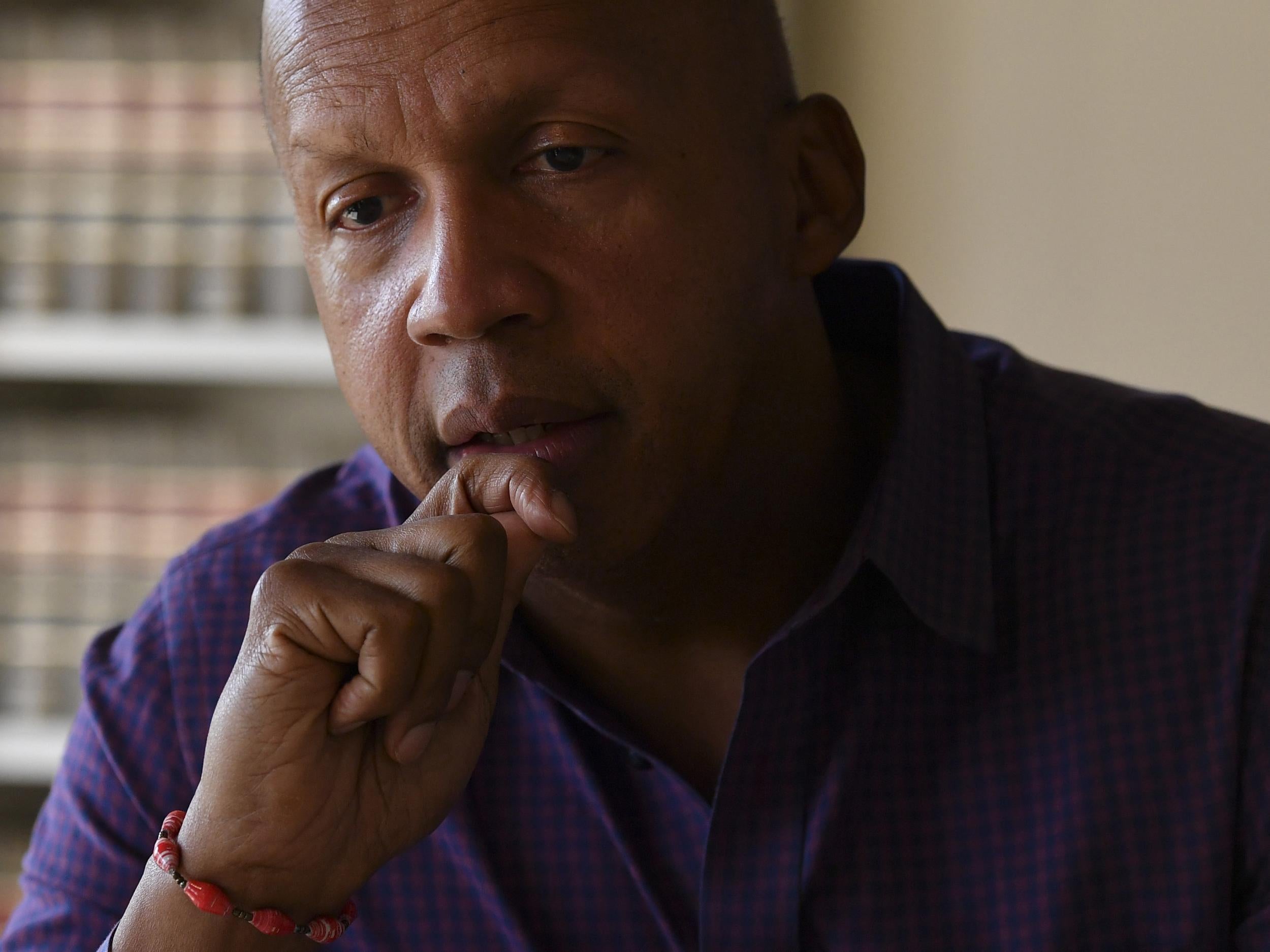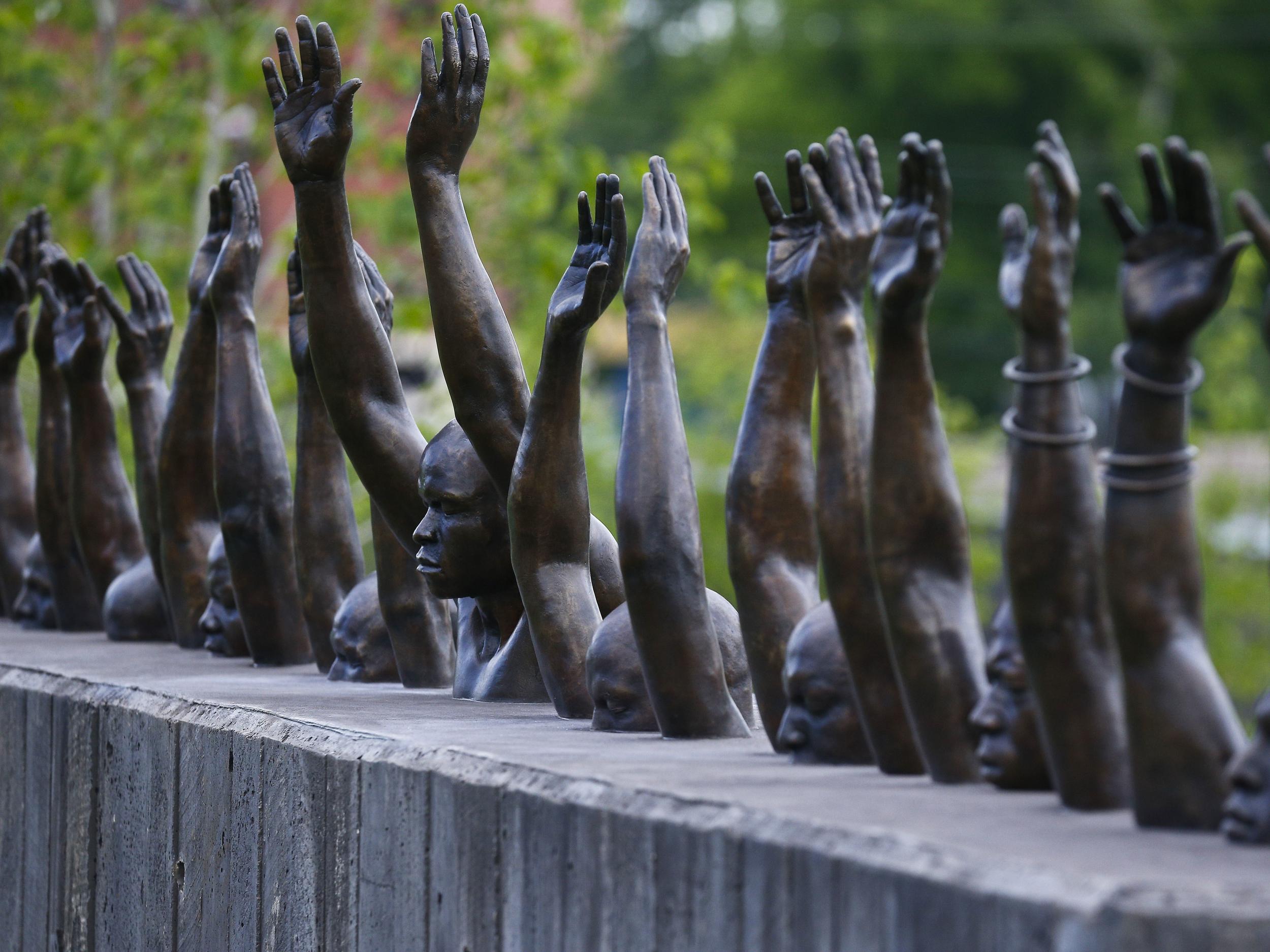Alabama's new lynching memorial confronts America's brutal history of racial terrorism
More than 800 jars of soil from lynching sites across the country are being exhibited in the museum that traces the history of enslaved black people in America

Your support helps us to tell the story
From reproductive rights to climate change to Big Tech, The Independent is on the ground when the story is developing. Whether it's investigating the financials of Elon Musk's pro-Trump PAC or producing our latest documentary, 'The A Word', which shines a light on the American women fighting for reproductive rights, we know how important it is to parse out the facts from the messaging.
At such a critical moment in US history, we need reporters on the ground. Your donation allows us to keep sending journalists to speak to both sides of the story.
The Independent is trusted by Americans across the entire political spectrum. And unlike many other quality news outlets, we choose not to lock Americans out of our reporting and analysis with paywalls. We believe quality journalism should be available to everyone, paid for by those who can afford it.
Your support makes all the difference.A white mob yelling, “Lynch him!” pulled Matthew Williams from the Negro ward of a hospital in Salisbury, Maryland, on 4 December 1931. Williams, who had been shot in the leg, was accused of killing the white man he worked for after a pay dispute.
Williams denied the allegation, but the 23-year-old was bound in a straitjacket and thrown out the hospital window. The mob stabbed him with ice picks, dragged his body three blocks to the courthouse in downtown Salisbury, a small city on Maryland’s Eastern Shore. There, they laced a rope over a tree and tied the other end around Williams’ neck.
Standing on the courthouse lawn, the mob taunted Williams, raising and lowering his body several times before finally dropping him to his death. After more than five hours of abusing the body, the mob cut the rope, tied Williams to the back of a truck and dragged him through Salisbury’s black community. Before burning his body, they cut off his fingers and toes and threw them on porches in the black neighbourhood, shouting “Make n****r sandwiches.”
Nearly 100 years later, community members working with the Equal Justice Initiative, a legal rights organisation in Montgomery, Alabama, collected soil from the site where Williams was killed, put the soil in a jar and carried it to Montgomery, where the jar is being displayed in an exhibit at EJI’s new Legacy Museum, which opened last month.
More than 800 jars of soil from lynching sites across the country are exhibited in the museum that traces the history of enslaved black people in America from the horrors of slavery to the terrors of lynching, the humiliation of Jim Crow and the current crisis of police brutality.
A few blocks from the museum, the National Memorial for Peace and Justice, also opened last month, becomes one of the country’s first memorials dedicated to Williams and more than 4,000 other lynching victims. The six-acre site contains 801 6ft monuments constructed of corten steel to symbolise their brutal deaths, museum officials say.
The names of the victims are carved into the steel columns that dangle from beams, much like the lynched bodies of men, women and children dangled from trees.
The opening of the museum and memorial comes at a time when Confederate statues and monuments are being removed from public spaces in many cities and towns as the country struggles to come to terms with its history of slavery, Jim Crow laws, lynchings, segregation and racial oppression. Even Richmond, Virginia, once the capitol of the Confederacy, is debating what to do with the massive statues of General Robert E Lee, Jefferson Davis and other Confederate leaders that line Monument Avenue.
At the same time, new museums dedicated to black history have opened to huge crowds, including the Smithsonian’s National Museum of African American History and Culture and the Mississippi Civil Rights Museum.
Bryan Stevenson, founder and director of the Equal Justice Initiative, said the country cannot heal until it confronts the truth of what happened, especially in the South.
“This landscape is littered with a kind of glorious story about our ‘romantic past’,” said Stevenson, a lawyer who has helped overturn the convictions of more than 125 wrongly condemned prisoners on death row. “You can’t say that if you fully understand the depravity of human slavery, of bondage, of humiliation and rape and torture and lynchings of people.”
Lynchings were a tool used to oppress black people after the Civil War. They were often committed by mobs who murdered victims with impunity, often in the presence of law enforcement or on courthouse lawns.
The Equal Justice Initiative began work on the memorial in 2010 while investigating thousands of lynchings that occurred from 1877 to 1950 in the Deep South. In 2015, EJI released its report “Lynching in America: Confronting the Legacy of Racial Terror”, which documented more than 4,400 lynchings of black people – 800 more than had been previously reported.
“I get asked, ‘Why is a lawyer trying to do a museum and memorial?’,” Stevenson said during an interview in his office on Commerce Street, a historic street in Montgomery that was the site of “slave pens” and warehouses where enslaved people were marched in chains from the river and railroad to slave auctions.
“It really springs from that experience of representing people in courts and beginning to see the limits of how committed our courts are to eradicating discrimination and bias. I want to get to the point where we experience something more like freedom... I don’t think we are going to get there until we create a new consciousness about our history.”

The Equal Justice Initiative raised more than $20m (£14.8m) from private donations, he said, many of them people who gave $20, $30, or $100 each.
The Peace Memorial, which is a few blocks from the museum, sits on the highest hill in Montgomery, which during the Civil War was the first capital of the Confederacy.
Near the entrance to the memorial stands a concrete sculpture by artist Kwame Akoto-Bamfo, which depicts six figures in chains and a woman carrying a baby and reaching out to a man who is bound in agony. Rust from the chains drips down the bodies of the enslaved figures.
The memorial opens with the sculpture depicting slavery, Stevenson said, because “that is the beginning of the narrative of what happened to people of colour”. Without slavery, “it wouldn’t be possible for white families to gather their children and go downtown to the courthouse square and watch a black person be burned to death, to watch a black person be hanged, to watch a black person be tortured”.
The steel monuments, organised by county, appear like gravestones at eye level. Then they begin to rise, until they are dangling overhead like vertical steel coffins.
“Lifting up those monuments was really important because the people who carried out lynchings could have murdered people and buried the bodies in the ground, they could have hidden the evidence,” Stevenson said. “But they didn’t want to do that. They wanted to lift it up to raise it over the entire community so every black person would be menaced and traumatised and terrorised.”
The final section of the memorial features short, horrifying narratives about lynchings: “Seven black people were lynched near Screamer, Alabama, in 1888, for drinking from a white man’s well.” “Dozens of black sugar cane workers were lynched in Thibodaux, Louisiana, in 1887 for striking to protest low wages.” “David Walker, his wife, and their four children were lynched in Hickman, Kentucky, in 1908 after Mr Walker was accused of using inappropriate language with a white woman.”
And there is a wall dedicated to the undocumented victims of lynching. “We identified over 4,000,” Stevenson said, “but we know there are thousands more.”
In an adjacent garden lie 801 steel monuments identical to those hanging in the memorial. These replica monuments await representatives from counties where the lynchings occurred to claim them, take them back home and display them as a testimony to what happened, and efforts at truth and reconciliation, said Sia Sanneh, an EJI senior attorney who worked on the project.
“We hope over the years the entire landscape of America will change as these markers are claimed,” Sanneh said.
The monument for Wicomico County, Maryland, bears three inscriptions:
GARFIELD KING 05-26-1898
MATTHEW WILLIAMS 12-04-1931
UNKNOWN 12-06-1931
The unknown was a man who was killed in Salisbury just two days after Matthew Williams was lynched. According to the EJI report: “On the morning of 6 December 1931, a second victim of the white mob that killed Matthew Williams was found on the corner of College Avenue and Railroad Street. He was found dressed in blood-soaked overalls, a sweater, a brown khaki shirt, and worn Army shoes.”

“He was about 35 years old and weighed about 160 pounds, and police found bacon and half a ham, wrapped in brown paper, near his body. Authorities concluded he had gone to the grocery store on the evening of 5 December and was attacked and murdered by the white mob on his way home. The attack left the man unrecognisable, fracturing his skull and crushing the entire left side of his face, and his name remains unknown.”
Six months ago, EJI staff travelled from Alabama to Maryland help volunteers collect soil from six lynching sites on the Eastern Shore. They started in Somerset County, where George Armwood was lynched on 18 October 1933 – the last recorded lynching in Maryland. Next they drove to Salisbury, where Garfield King, 18, was lynched in a public spectacle on the courthouse lawn in 1898. Then they travelled next to Princess Anne, where Isaac Kemp, 23, was lynched in 1894.
They returned to Somerset County, where William Andrews, 17, was lynched by more than 1,000 people on 9 June 1897, after a white woman accused him of assaulting her. The teenager said he was innocent, explaining the woman had passed him earlier that day while he was picking strawberries. The mob hanged his body from an oak tree near the courthouse.
The volunteers collected soil from Crisfield, where James Reed, 22, was lynched on 28 July 1907. Finally, they went to the Salisbury courthouse lawn, where Matthew Williams was attacked. After filling a jar with rich black soil, they placed it next to a marker honouring Confederate Gen John Henry Winder.
“It felt like a small act of atonement,” said James Yamakawa, 37, a stay-at-home father who volunteered for the project. “There is something about digging your hands in the soil, where you know someone was brutally murdered. At least it felt like I could ease some of that history. I know there is a lot of history in this country that has not been told. A lot of it is because people are afraid they will be asked to make up for it.”
Steven Williams, 21, a senior at Salisbury University, said he found the experience “very spiritual, very surreal to be in a vicinity of where there was atrocities and murders such as lynchings”.
He and others who collected soil at the place where William Matthews was killed are looking forward to claiming Wicomico County’s replica monument.
“To know a piece of the Eastern Shore is down there in Montgomery, a part of this larger project, is reaffirming and empowering,” said Amber Green, founder of the Phoenix Youth Project, a group that participated. “To know we were part of something big is like ripples turning into waves.”
© Washington Post
Join our commenting forum
Join thought-provoking conversations, follow other Independent readers and see their replies
Comments